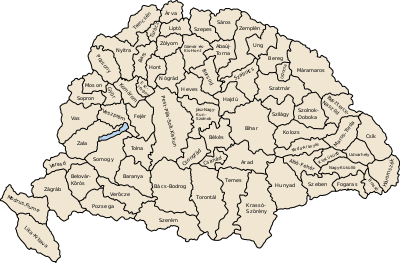Nógrád County (former)
Nógrád (Hungarian; Latin: comitatus Neogradiensis, German: Neuburg or Neograd, Slovak: Novohrad) was an administrative county (comitatus) of the Kingdom of Hungary. Its territory is now divided between Hungary and Slovakia. The name Novohrad is still used in Slovakia as an informal designation of the corresponding territory. The name is derived from the former Nógrád castle in Hungary.
| Nógrád County | |
|---|---|
| County of the Kingdom of Hungary (11th century-1923, 1938-1945) | |
_v2.svg.png) Coat of arms
| |
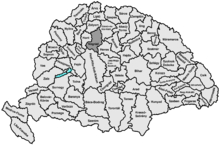 | |
| Capital | Balassagyarmat |
| Area | |
| • Coordinates | 48°5′N 19°18′E |
• 1910 | 4,128 km2 (1,594 sq mi) |
| Population | |
• 1910 | 261517 |
| History | |
• Established | 11th century |
• Treaty of Trianon | 4 June 1920 |
• Merged into Nógrád-Hont County | 1923 |
• County recreated (First Vienna Award) | 1938 |
• Remerged into Nógrád-Hont County | 1945 |
| Today part of | (2,381 km2) (1,747 km2) |
Geography
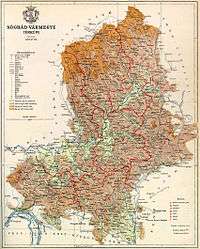
In 1910, Nógrád county shared borders with the counties of Hont, Zólyom, Gömör-Kishont, Heves and Pest-Pilis-Solt-Kiskun. It was situated approximately along the line Poltár, Losonc (today Lučenec), Szécsény and Vác. The river Ipoly (Slovak: Ipeľ) flowed through the county. Its area was 4,133 km² around 1910.
Capitals
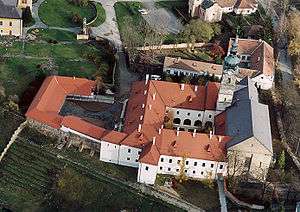
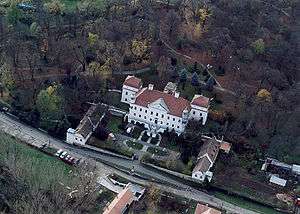
The capital of the county was Balassagyarmat, except for the 18th century, when the capital was Losonc.
History
Nógrád was one of the first counties of the Kingdom of Hungary, founded in the 11th century. Large part of it's territory was ruled by the Ottoman Empire from 1541 to 1595, and from 1605 to 1686, as part of Budin Province and Eğri Province.
In the aftermath of World War I, the part of Nógrád county north of the river Ipeľ/Ipoly became part of newly formed Czechoslovakia (as Novohrad county), as recognized by the concerned states in 1920 by the Treaty of Trianon. The southern part stayed in Hungary and was merged with the Hungarian part of Hont county to form Nógrád-Hont County in 1923. Following the provisions of the First Vienna Award, the northern half of the county was redeemed thus and the county had was recreated in 1938. After World War II, the Trianon borders and Nógrád-Hont County were restored. In 1950 the county was again recreated after some of its parts were passed to the newly formed Pest County and the reorganized Heves County.
In 1993, Czechoslovakia dissolved and Novohrad became part of independent Slovakia. Since 1996, it has been part of the Slovak administrative unit Banska Bystrica region.
Demographics
1900
In 1900, the county had a population of 239,097 people and was composed of the following linguistic communities:[1]
Total:
- Hungarian: 168,614 (70.5%)
- Slovak: 64,287 (26.9%)
- German: 3,958 (1.7%)
- Romanian: 83 (0.0%)
- Croatian: 33 (0.0%)
- Serbian: 19 (0.0%)
- Ruthenian: 16 (0.0%)
- Other or unknown: 2,087 (0.9%)
According to the census of 1900, the county was composed of the following religious communities:[2]
Total:
- Roman Catholic: 172,804 (72.3%)
- Lutheran: 52,205 (21.8%)
- Jewish: 9,541 (4.0%)
- Calvinist: 4,195 (1.8%)
- Greek Catholic: 212 (0.1%)
- Greek Orthodox: 103 (0.0%)
- Unitarian: 16 (0.0%)
- Other or unknown: 21 (0.0%)
1910
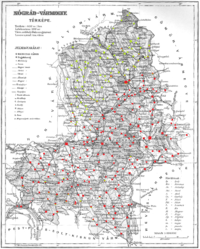
In 1910, the county had a population of 261,517 people and was composed of the following linguistic communities:[3]
Total:
- Hungarian: 197,670 (75.6%)
- Slovak: 58,337 (22.3%)
- German: 3,143 (1.2%)
- Croatian: 52 (0.0%)
- Serbian: 36 (0.0%)
- Romanian: 33 (0.0%)
- Ruthenian: 4 (0.0%)
- Other or unknown: 2,242 (0.9%)
According to the census of 1910, the county was composed of the following religious communities:[4]
Total:
- Roman Catholic: 193,449 (74.0%)
- Lutheran: 52,991 (20.3%)
- Jewish: 9,641 (3.7%)
- Calvinist: 4,934 (1.9%)
- Greek Catholic: 329 (0.1%)
- Greek Orthodox: 124 (0.0%)
- Unitarian: 19 (0.0%)
- Other or unknown: 30 (0.0%)
Subdivisions
In the early 20th century, the subdivisions of Nógrád county were:
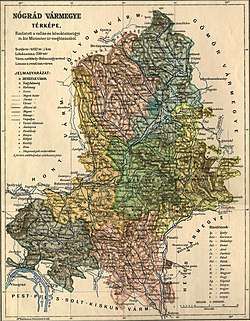
| Districts (járás) | |
|---|---|
| District | Capital |
| Balassagyarmat | Balassagyarmat |
| Gács | Gács (now Halič) |
| Losonc | Losonc (now Lučenec) |
| Nógrád | Rétság |
| Salgótarján | Salgótarján |
| Szécsény | Szécsény |
| Szirák | Szirák |
| Urban districts (rendezett tanácsú város) | |
| Losonc (now Lučenec) | |
The towns of Lučenec and Halič are now in Slovakia.
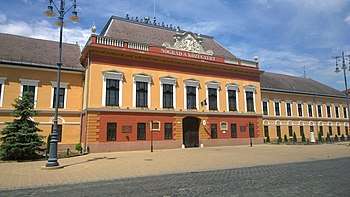
References
- "KlimoTheca :: Könyvtár". Kt.lib.pte.hu. Retrieved 26 June 2012.
- "KlimoTheca :: Könyvtár". Kt.lib.pte.hu. Retrieved 26 June 2012.
- "KlimoTheca :: Könyvtár". Kt.lib.pte.hu. Retrieved 26 June 2012.
- "KlimoTheca :: Könyvtár". Kt.lib.pte.hu. Retrieved 26 June 2012.
